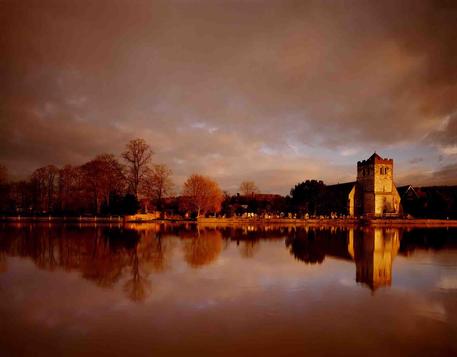
Photograph copyright ©1999 - 2018 Denis Waugh.
External Links
BISHAM
Bisham Abbey now houses the Central Council of Physical Education and is a centre of excellence for just about every sport you can think of, from archery to weight lifting. It was built, though, in the twelfth century as a preceptory, which is a subordinate community of the Knights Templar. On dissolution of the Order by Philip IV (the Fair) of France on pretty spurious charges of heresy, blasphemy etc. it became an Augustinian Priory and then a Benedictine abbey. It is also the burial place of the illustrious Nevilles.
In 1463 Richard Neville, Earl of Warwick (a.k.a. Warwick the Kingmaker) staged a showpiece service here for the reburial of his father and his brother, killed at Pontefract. It was designed, perhaps, as a challenge to Edward IV, who had recently held a memorial service for his father and brother, killed at Rutland.
Warwick's problem was perhaps basically jealousy. He found it difficult to come to terms with the increasing popularity of his tall and handsome cousin Edward when the hero's role had for so long been his. The term `kingmaker' was applied to him because the fortunes of his two kingly cousins: Henry VI of Lancaster and Edward IV of York, waxed and waned according to his support. His last change of side was to Henry in 1471, when he was killed during the Battle of Barnet. His body was exposed for three days on pavement of St Paul's so there could be no doubt about his death. Then he was buried in the Abbey of Bisham. After his death the Nevilles lost some of their aura, because no one wants to be associated with a loser.
Strangely, his two daughters were married into both the Lancastrian and Yorkist families. Isabel married the Duke of Clarence who, in Shakespeare's Richard III was drowned in the butt of malmsey and Anne married Prince Edward, son of Henry VI. She is Shakespeare's `Lady Anne'. Bisham Abbey became a country house for Anne of Cleves on her divorce from Henry VIII, six months after her wedding at age 23. Holbein, having been despatched to paint her, had done neither Anne nor the king any favours with his depiction of an attractive and graceful girl.
`I like her not,' Henry announced on finally meeting her. Anne had a `gravity of face' that displeased him. We never hear what she thought when confronted with this grossly fat man, old before his time. Henry (although of course it was Anne's fault) was unable to consummate the marriage. He insisted that he doubted her virginity and was thus disinclined to perform his marital duty. Anne took Henry's decision that their marriage was `invalid' with equanimity and wrote to her brother the Duke of Cleves begging him not to rock the boat - lest her fate be rather worse than retirement to the state of `the king's well loved sister'.
Anne was always good to Elizabeth, who spent a lot of time here as a child, and whom most people seem to have treated in a rather off-hand manner - certainly when compared with her siblings Mary and Edward - and she developed a taste for fleshly compensations. Supplies for her London dwelling in 1556 are recorded as `two hogsheads of beer of a ton each, three hogsheads of Gascon wine, ten gallons of Malmsey wine, ten gallons of sack...'
Elizabeth I had other friends here besides her stepmother Anne. Bisham Church contains fine monuments to the Hoby family, who cared for the king's sadly neglected second daughter. Sir Philip Hoby was Henry's special envoy, despatched with Holbein on his next trip to ensure he didn't exaggerate the attributes of the future marriage candidates. Especially the tall and lovely Christina of Denmark, aged 16, recently widowed by the Duke of Milan, whose portrait now hangs in the National Portrait Gallery. On being assured that the king was `the gentlest of gentlemen' it is reported that Christina hid her face behind her fan, which shook uncontrollably. Emerging with a very nearly straight face, she replied demurely that if she had two necks the king should have one of them.
Text copyright ©1999 - 2018 Priscilla Waugh.